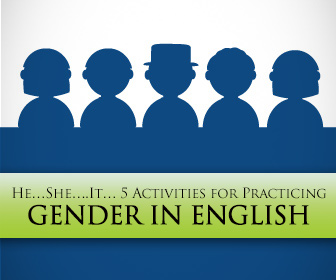He…She….It… 5 Activities for Practicing Gender in English


When you introduce your students to an issue that brings out their emotions, they will be motivated to speak. Not only that, but because they are invested in their own opinions, your students will have more natural language production. For anyone who gets emotional when he speaks, his natural accent, grammar and vocabulary come out stronger and are easier to observe. When your students are talking this way, you, their teacher, can get a good read on how much English they have really acquired. Following is a unit that examines how the media communicates a message about beauty that is sure to get your students talking.

The media has an enormous amount of influence on young people today, and those who look can find plenty of hot topics to discuss in the classroom. One of the issues that may not come to mind as quickly as others is the idea of what it means to be beautiful. Young people are inundated with images that speak to physical beauty – through television, advertisements and celebrity culture. This constant message plays into each of our self images. However, most of the time we accept the message the media supplies and fail to question the truth of that message. Getting your students to think about what defines beauty will have benefits on multiple levels. They will get talking about a personal and important topic; they will gain perspective on the message the media is sending their way; and they may end up having a better body image when they take a critical look at the media and themselves.
Give your students some time to look through magazines and online for advertisements that speak to or of personal beauty. They may point out men and women, young people and old being portrayed as beautiful or not beautiful. Challenge your students to also notice phrases and words the advertisers use to communicate the idea of beauty. Let small groups of students work together to compile a list of what they find, and challenge each group to write their own definition of beauty as it is represented in the media images.
Is the way magazines portray beauty an accurate representation of true beauty? For women? For men? Answers may fall anywhere on a wide spectrum, but encourage your students to share their own opinions with their small discussion groups. If you like, have each person write a reaction which answers the same questions. Make sure your students know as they discuss that disagreements are bound to come out. The key is continuing to be respectful to the others in the group, listening, offering contrary opinions in a normal tone of voice, and agreeing to disagree when necessary. Then take the discussion a step further by asking your students how much of this message ties into the financial benefits for product designers and advertisers. Should it? How can everyday people take measures to improve the media’s message as well as their own reception of that message?
In English, some adjectives describing beauty are traditionally reserved for solely men or solely women. Fewer may be used to describe both genders. Such words include attractive or cute. Men specific adjectives include handsome and dapper. Women have their own, too, including pretty and voluptuous. Challenge your class to see how many words used to describe beauty they can list. Start with one general list and then challenge pairs or groups of students to determine which are reserved primarily for describing men, which for women and which can be used for either. Allow your students to use a thesaurus and offer some suggestions of your own. Once everyone has classified the adjectives, take some time to share your classification with the class and see if everyone agrees.
Depending on the ages and personalities of your students, you may or may not want to break your class into two groups, male and female. (This is particularly beneficial for adolescents, but younger children may do best to skip this activity.) Once you have your male and female groups and a moderator of the same gender for each, ask your students if they ever feel unhappy with the way their bodies look. Allow any willing student to share, and make sure individuals do not feel pressured to share if they are not comfortable doing so. For those who do share, ask if they can explain why they feel the way that they do. Challenge your students to think about how their self assessments could lead to negative behavior. After the group discussion, give students some time to journal about what you have discussed in class.
Your students may be feeling a lot of different emotions at this point in the discussion on beauty. Some may feel an improvement in their self esteem. Some may feel frustrated at how the media has such an influence in their lives. Give your students a chance to send the right message by creating their own advertisement which communicates a healthy body message. Ask each student to choose an ad you used in the first activity and create an original advertisement for the same product or service. Because not everyone will have advanced artistic abilities, allow your students to formulate their advertisement as a collage or original piece of art work, tracing and stick figures accepted. When the ads are finished, post them on a bulletin board next to the original advertisement. If you like, extend the activity and ask your students to choose a pair of advertisements and write a compare/contrast composition about them.
Open up the channels of communication in your classroom and get your students talking about this issue on which they might not agree. As long as everyone is using the language they know to express their ideas, everyone in your class will have one.
Have you used controversial topics in the classroom? What were the results?